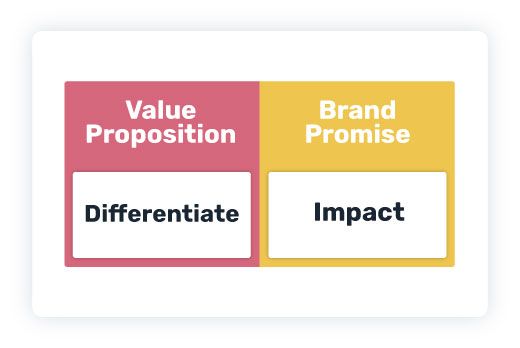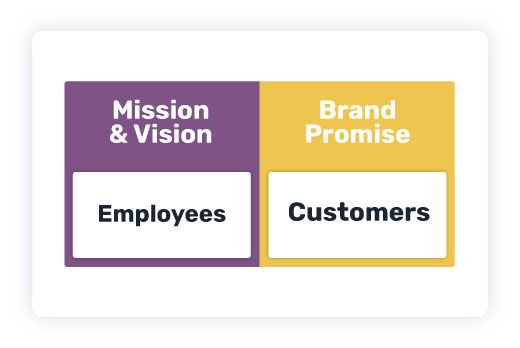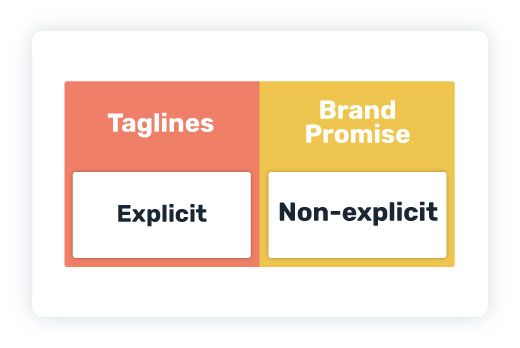What’s a brand promise and why is keeping one important if you want to grow fast? Find out today.
“That caused us to go, wait a sec, we need to figure out what role we play in people’s life and so we did deeper dive-dive research with the world at large, not just our members, to find out what we needed to be. And we arrived at the brand promise."
-Barry Enderwick, Kaizen Creative Partnership
Today, you’ll learn how to create a compelling brand promise and why keeping that promise is so important to brand growth. We’ll also quiz your knowledge using examples from household names like Apple, Disney, and Burger King.
Plus, we’ve got special guest Barry Enderwick to share with us what he learned about the Netflix brand promise during his time driving growth at the streaming service-turned production company.
Stay tuned.... but before that, download our free worksheet to help you create the perfect brand promise.
What’s a Brand Promise? (And Why Are They Important?)
First, what exactly is a brand promise? While there isn’t a shared textbook definition in the branding world, there is a general agreement about what a brand promise isn’t.
Unlike your brand’s unique value proposition, which is the thing that sets you apart from your competition, your brand promise is the resulting feeling customers get because they chose your brand.

Unlike a brand’s mission and vision, which are focused on employees, a brand promise focuses on customers.

And unlike taglines, which are always customer-facing, brand promises aren’t usually explicitly used in marketing content or advertising copy.

And so… What is a brand promise? A brand promise is the positive feeling or outcome that consumers can expect when they experience the brand.
And brand promises are important because when kept, they help build trust with customers, which leads to brand growth and revenue growth.
How to Create a Strong Brand Promise (With Examples)
According to the Disney Institute, a good brand promise is important, credible, exclusive, and differentiating.
Keep these principles in mind as you create your own brand promise as a way to test its strength and how well it fits with your brand.
Let’s cement your knowledge with the brand promises of some household names to help make the concept even more clear.
Brand Promise Examples:
- Adidas: To change lives through sport
- Amazon: To be Earth’s most customer-centric company
- Apple: To think different
- BMW: To provide driving enjoyment
- Burger King: To serve your food your way
- Coca-Cola: To refresh the world and to inspire moments of optimism and uplift
- Disney: To provide magical experiences
- Facebook: To build a global community
- Google: To organize the world’s information and make it useful
- Hilton: To deliver exception guest experiences
- IKEA: To offer a wide range of well-designed, functional home furnishing products at prices so low that as many people as possible will be able to afford them
- Lime: To unlock life
- Marriott: To provide quiet luxury, crafted experiences, and intuitive service
- McDonald’s: To provide simple, easy enjoyment
- Netflix: Movie enjoyment made simple
- Nike: Inspiration and innovation for every athlete in the world
- Samsung: To perform responsibly as a leading, global company
- Sonic: To be America’s drive-in
- Starbucks: To serve the best coffee possible
- Tesla: To accelerate the world’s transition to sustainable energy
- Uber: To move people to where they want to be
- Walmart: To create convenience at the lowest price
How to Keep a Brand Promise
Now that we know what a brand promise is and why they’re so important, let’s take a look at how to actually to deliver on that promise.
For that, I interviewed Barry Enderwick on Growing Brands. Barry is the Co-Founder and Partner of Marketing & Brand at Kaizen Creative Partnership. I asked him about his time at Netflix and how the brand's promise impacted subscriber acquisition efforts during the fastest period of growth in the company’s history.
Watch the episode to hear Barry answer these questions:
- How important is brand in general to a company’s go-to-market strategy?
- How can you tell whether a company is delivering on its brand promise? What signs or indicators do you tell people to look for?
- What was Netflix’s brand promise and how did it influence company decisions when you were there?
Brand Promise, in Closing
If you liked this episode, take a few seconds to subscribe. Or you can head to the blog for a free worksheet on how to craft the perfect brand promise. And while you’re there, sign up for our newsletter, which contains exclusive brand measurement and growth tips that will help your brand become the market leader.
Now it’s your turn.
What is your favorite brand promise and why? Is it one of the examples that we shared or is it from a different brand altogether (maybe it’s your own brand)?
What are the best ways for brands to deliver on their promise? And how do they define and measure success?
Let me know by leaving a comment real quick before you leave.
Transcript from our interview with Barry Enderwick:
So how important is brand in general to a company's go-to-market strategy? The answer to that question is depends, right? So if you're an early company that's trying to find product/market fit, just like you don't wanna necessarily invest in marketing, investing in brand is kind of a waste of time. You have to have an established, even if it's a small base of happy customers that you can then scale 'cause marketing is a scaling mechanism, and brand is important, but if you're in that stage, it's not important. And in fact, at Netflix, when I first got to Netflix, we had a brand promise that was, from my understanding, made up in-house, and we worked using that for about three years, three or four years, and then we did research around what our brand position should actually be, and then pivoted to that. So I think brand is critical for companies to understand what role they play in people's lives, but it also depends on what state the company is at. Yeah, that's a great point and I think, to that, and as well, a lot of times brands, especially in their early days while they're trying to find product/market fit, the actual growth marketers that are doing that are hesitant to kind of experiment with the brand or make assumptions about the brand because they feel like that's kind of not their place 'cause it's more of the branding team to do that, maybe. But I like your suggestion of kind of taking your best guess for maybe the first couple of years until you've got that product/market fit, and then doing that next round of research to make sure that you really nail the brand positioning as you grow. So how can you tell whether a company is delivering on its brand promise, and what signs are indicators do you tell people to look for? Well, based on my experience at Netflix, which is admittedly a unique business model, it's still subscription, but we would look at, we would do things like customer surveys, member surveys to kind of take the pulse of our brand. And also, you take a look at churn, and we do exit surveys. And so you just sort of keep these pulse checks going at all times to see if something is not matching up with what you're trying to put out there. And in fact, one of the weird things that led to us doing that repositioning research in 2004, 2005, was we did a survey with our members and asked them what they thought of us. Our brand position up until that point was the best way to rent DVDs, which sounds great, it's got best in it. But when we surveyed our members, they basically came back and said, "You're an efficient vending machine," which from a brand standpoint is terrible because anybody can build an efficient vending machine. They can build a more efficient one, a better stock, whatever. So then we did that, caused us to go, "Wait a sec, we need to figure out "what role we're playing in people's lives." And so we did more bigger, deeper dive research with the world at large, not just our members to find out what we needed to be, and we arrived at the brand promise of movie enjoyment made easy, 'cause everything about seeing a movie was kind of a pain. You had to get in your car to go to the theater and spend lots of money, or you had to get in your car to go to the blockbuster or the video rental store, and then you had to get it back in time because of late fees. Nothing about movie enjoyment was easy. So if we could pay that off, we'd have something there. Okay, that's great. So the Netflix brand promise was movie enjoyment made easy. So let's unpack that a little bit more. So how did it influence company decisions at the time and how did that lead to growth for not just the product but also acquisition of customers and the brand as well? Yeah, well, it's interesting 'cause once you have that sort of flag that you're all paying attention to of the brand promise, you can start to influence what kind of decisions you make on product, customer service, marketing. So for example, at the time, we did what every subscription company has done and some continue to do, which is mind-blowing, and that is call to cancel. And that is painful, everyone hates it, so we moved to two clicks on the website to cancel. And on our exit surveys, likelihood to recommend and likelihood to return rates shot up. People couldn't believe that they were just let, "Yeah, you can go ahead and quit. "You come back when you want to." And it worked, people did start coming, they would quit for whatever reason, like the summer is there and they weren't gonna be watching DVDs 'cause they're gonna be traveling a lot, then they come back in the fall. And it all drove towards that movie enjoyment made easy. In the ops area of the company, we built out a network of hubs and mini hubs across the country, and that allowed people to get their DVDs in one business day via the United States Postal Service, which I can tell you right now, would not have happened organically. So decisions like that were made for movie enjoyment made easy. How do we pay that off? So in the marketing, what we thought of is what are the different themes that we have that support movie enjoyment made easy? Well, there's price, there's a free trial, low price, it's unlimited process. You pick your movies online, they get delivered to you. You don't have to do anything. You don't have to get in a car and do anything. Trust. We've been doing it for X number of years. We've delivered over a billion DVDs so far. So you come up with these themes, you start to develop benefit-driven headlines, and then you have support points that you use and you apply consistently. And the other thing is, and we're not talking about brand attributes, but I feel I need to bring this up. Our brand attributes, which supported the brand promise, also guided decisions on, like, what font to use, like I chose the font Gotham back in 2004 because it was very strong, but friendly. It supported and aligned with our brand attributes to support the brand promise. And illustration styles, all that kind of stuff, kind of tie all in together. So then what happens is you get this cohesive brand in the consumers' mind, and everything we're talking about in marketing movie enjoyment made easy, we're paying it off in our ops, we're paying it off in our service. That's great. So there's a lot of cascading benefits that start with the brand promise, out into other brand attributes, and ultimately, that supports the customer acquisition plan, the company growth plan, and of everything. So Barry Enderwick, thank you so much for your time, really appreciate it. Yeah, you're welcome, happy to do it. Thanks for having me.


